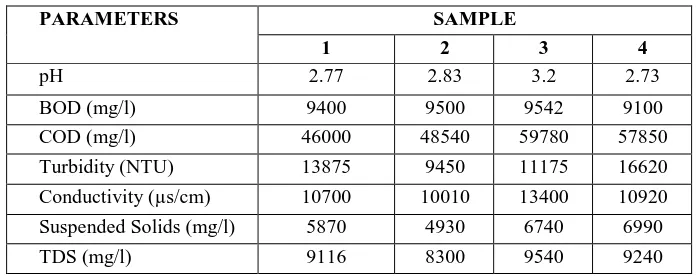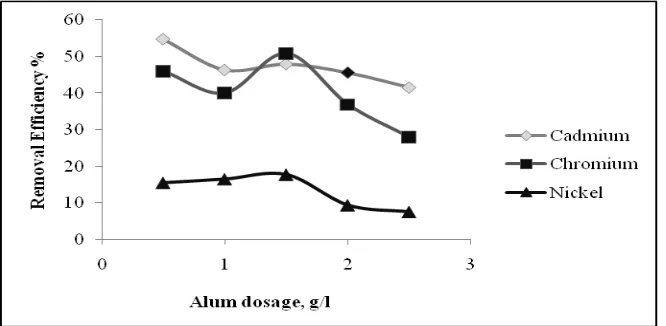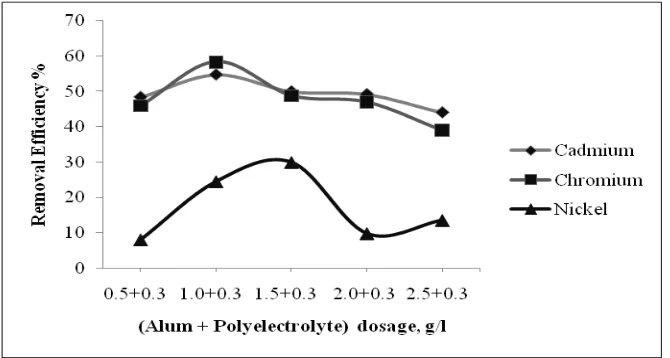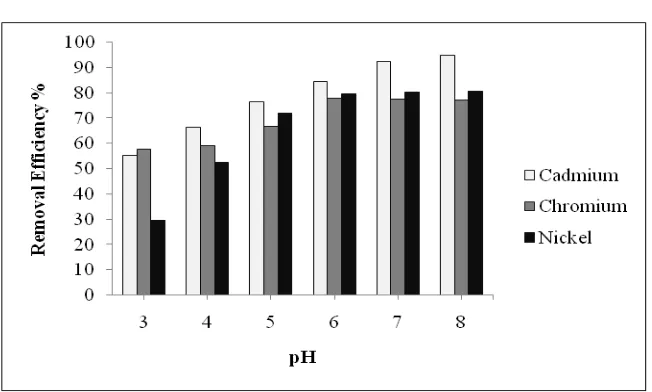Coagulation Study to Remove Heavy Metals
from Leachate
Shweta .S. Angadi
1, Rashma Shetty
2, Manjunath N.T.³
P.G. Student, Department of Studies in Civil Engineering, U.B.D.T. College of Engineering, Davanagere, Karnataka, India1
Assistant Professor, Department of Studies in Civil Engineering, U.B.D.T. College of Engineering, Davanagere, Karnataka, India2
Professor & Director, Department of Studies in Civil Engineering, U.B.D.T. College of Engineering, Davanagere, Karnataka, India³
ABSTRACT: Leachate is a concentrated liquid that originates from solid waste dumping sites. Releasing of leachate to the environment without treatment pollutes the soil, surface and ground water. In this study leachate is treated with Alum and in conjunction with polyelectrolyte to remove heavy metals. The Alum with Polyelectrolyte has shown higher removal efficiency of heavy metals. Alum of dosage 1 g/l and combination with 0.3g/l of polyelectrolyte produced optimum results in removal of Cadmium, Chromium and Nickel removal efficiencies being 92.4%, 77.3% and 80.1% respectively at pH 7.
KEYWORDS:Leachate, coagulation, polyelectrolyte, pH, dosage.
I. INTRODUCTION
Solid waste generation is growing rapidly due to change in life style and urbanization. Unscientific waste handling and management cause environment degradation and health hazards. In many cases the solid waste are either dumped in the open land or follow the sanitary landfill method for management of solid waste which is cost effective.
One of the greatest disadvantages of landfill method is leachate formation. Leachate is any liquid which is highly complex and polluted, produced due to the percolation of water through the body of landfill. In terms of pH, the leachate could be categorized as alkaline for old leachate and acidic for fresh leachate [1]. In India, the leachate is disposed of on open lands and it is fully exposed to water body thus leading to a drastic increase in pollution level of the surroundings [2].
A variety of waste is dumped in different landfill site of the city, which likely indicates the origin of Pb, Zn, Cu, Fe, Ni and Mn in leachate [3]. When leachate reaches the water by percolation or surface runoff, it causes water pollution. Heavy metals are drained regularly without proper treatment, then after some years the ground water will not be suitable for drinking purpose and it may cause diseases in the human being and animals.
There are several of methods to treat the leachate, in that coagulation is one of the treatments which is commonly used. Coagulation is generally achieved by adding different types of chemicals (like Alum, Ferric chloride, Ferric sulphate etc). These chemicals promote destabilization of colloidal dispersion and cause the agglomeration of colloidal particles. Once charge neutralisation takes place various particles come together which will result into coagulation [4]. The use of anionic polymers with metal salts has been reported to results in a number of benefits. Synthetic polymer will gives less sludge volumes, bigger and compact flock are achieved with greater settling rates [5].
leachate treatment by using Ferric chloride and Alum as coagulant. Ferric chloride showed the highest removal efficiency of suspended solids (96%), COD (37%), ammonical nitrogen (26%) and colour (84%) at pH 7 compared to alum. Lee Mao Rui et al. [6] conducted study on coagulation-flocculation in leachate treatment using combination of PAC with Cationic and anionic polymers. Result from his study showed optimum removal by PAC with combination of cationic polymer was 99.2% of Suspended solid, 59% of COD, 89.8% of colour and 49% of ammonical nitrogen. The optimum removal by PAC with combination of anionic polymer was 99% of Suspended solid, 56% of COD, 89.4% of colour and 46% of ammonical nitrogen.
Adnan A. et al. [7] conducted study on treatment of raw leachate from fresh solid waste and the test was carried out for heavy metals. This study used conventional coagulants of alum, polymer and natural indigenous okra. The analysed results showed that the optimum pH values were 6.65, 7.00 and 9.00 for alum, okra and polymer respectively. In addition, the optimum dose of alum was1400 mg/l and the removal efficiency of heavy metals was 45-80 %, while the optimum dose of polymer was 500 mg/L and the removal efficiency was of 70-95%. For okra, the optimum dose was 500 mg/L in which a removal efficiency of heavy metals was 20-100%. Polina Pilipenko [8] studied on cationic polyelectrolyte coagulant in municipal wastewater treatment. Polyelectrolyte dosage and treatment efficiency was predicted based on the raw water quality parameters, such as turbidity, suspended solids concentration and COD.
II. METHODOLOGY
The grab leachate samples were collected as per sampling procedure from Avaragolla solid waste dumping place near Davangere and analysed for its characteristics. The TMS solution was prepared using three metal compounds containing chromium, cadmium and nickel. 5.7g of Cadmium sulphate, 5.65g of Potassium Chromate and 13.45g of Ammonium nickel sulphate were dissolved in 1000ml of distilled water. Thus 1ml of TMS solution was found to contain 5 mg of Cd, 1 mg of Cr and 2 mg of Ni.
To begin with experiments were conducted to optimize the Alum dosage at pH 3. Further the studies were carried out to optimize pH value (3 to 8) for the optimized Alum dosage obtained in the 1st set of experiment. The experiments were also conducted to evaluate the effect of polyelectrolyte in conjunction with Alum in removing metals selected for study. 0.3g/l of polyelectrolyte was used for experimentation and Alum dosage was varied from 0.5g/l to 2.5g/l. Jar tests were performed by maintaining the speed of 100 rpm for 5 min & 50 rpm for 30 min. After jar test, the contents of the Jar were allowed to settle for 1hour. Then the supernatant was analysed for metal concentrations, using Atomic Absorption Spectrometer.
III.RESULT AND DISCUSSIONS
A. Leachate Characterisation
The characteristic analysis was carried out for leachate collected at different timings as per experimental requirements which are tabulated in Table 1. The leachate pH value of 2.73-3.2 observed indicated that the leachate is acidic and the metal concentration in the leachate detect were form to be very low concentrations and hence TMS 1 ml/l of leachate.
Table 1. Characteristics analysis of leachate.
PARAMETERS SAMPLE
1 2 3 4
Colour (ptCo) 21525 21010 23530 21910 Chlorides(mg/l) 46000 42580 43000 44180 Acidity (mg/l as CaCO3) 1200 1350 1450 1340
Cadmium (mg/l) 0.1 0.13 0.06 0.09 Chromium (mg/l) 0.09 0.05 0.1 0.06 Nickel (mg/l) 0.3 0.26 0.23 0.1
Results after TMS addition was compared to the typical values quoted by different authors shown in Table 2.
Table 2. Heavy Metals present in leachate from different sources
Heavy
metals
Leachate sample
of present work
(mg/l)
Value from
Bagdad [7]
(mg/l)
Value from
Iran [4]
(mg/l)
Nickel 2 5.97-6.42 0.65-3.8
Cadmium 2.5 1.02-3.7 0.07-0.34
Chromium 1 0.82-1.02 0.26-1.8
B. Optimization Study
The coagulation study was carried out for dosage optimization using sample containing heavy metals. Alum dosage was varied from 0.5g/l to 2.5g/l with difference of 0.5 g/l, and pH 3 was maintained (by adding HCL/NaOH). The results of experimentation are shown in Fig 1. The removal metal sequence of Cadmium>Chromium>Nickel was observed. The optimum Alum dosage was found to be 1.5g/l. At this optimum dosage the removal efficiency of 48%, 50.8% and 17.75% respectively were recorded for Cadmium, Chromium and Nickel.
In the second set of experimentation pH was varied from 3 to 8 and optimized Alum concentration of 1.5g/l obtained in the 1st set was maintained. The result of experimentation was shown in Fig 2. Linear relationship between pH and removal efficiency was observed up to pH 7. And further increase in pH 7 to 8, at optimum pH 7 removal efficiency of 86.8% (Cd), 66.7% (Cr) and 78.9% (Ni) were recorded.
Fig. 2. Effect on removal efficiency of parameter using optimum dosage of Alum at varying pH
Further the experiment was carried out to evaluate the removal efficiency with the addition of polyelectrolyte along with Alum. Experiment was conducted at pH 3 and polyelectrolyte concentration of 0.3g/l (each beaker) and by varying alum dosage from 0.5g/l to 2.5g/l. The results are represented in Fig 3. Within the statistical limitations the removal efficiency were found to be better corresponding to Alum dosage of 1g/l and polyelectrolyte dosage of 0.3g/l, the correspond of removal efficiency were respectively Cadmium, Chromium and Nickel of 54.8%, 58.4% and 24.5%.
Fig. 3. Effect on removal efficiency of parameter using varying dosage of Alum with polyelectrolyte (0.3 g/l) at pH 3
Fig. 4. Effect on removal efficiency of parameter using optimum dosage of Alum combination with polyelectrolyte at varying pH
IV. CONCLUSION
The experimental result shows that Alum improved its removal efficiency of heavy metals after adding polyelectrolyte. The removal efficiency of the heavy metal increases with increasing pH until it reaches to optimum pH 7. Alum of dosage 1g/l and combination with 0.3g/l of polyelectrolyte has given optimum result in removal Cadmium, Chromium, Nickel showing removal efficiencies of 92.4%, 77.3% & 80.1% respectively at pH 7.
REFERENCES
[1] Hamidi Abdul Aziz, Salina Alias, Faridah Assari, Mohd Nordin Adlan. “The use of Alum, Ferric chloride and Ferrous sulphate as coagulants in removing suspended solids, colour and COD from semi-aerobic landfill leachate at controlled pH”. University Saints Malaysia. 2007. [2] Sameer Kumar, DhruvKatoria and Gaurav Singh. Leachate Treatment Technologies. International Journal of Environmental Engineering and
Management, ISSN 2231-1319, Volume 4, Number 5, pp. 439-444, 2013.
[3] Awasthi A.K., Amit Pandey, Pandey A.K. and Jamaluddin, “Comparative study on heavy metal characteristics of leachate from municipal solid waste in central india”, IJSIT, 2(5), pp. 390-396, 2013.
[4] Afshin Maleki, Mohammad Ali Zazouli, Hassan Izanloo and Reza Rezaee. “Composting Plant Leachate Treatment by Coagulation-Flocculation Proces”,. American-Eurasian J. Agric. & Environ. Sci., 5 (5), pp. 638-643, 2009.
[5] Lee Mao Rui, Zawawi Daud, Abd Aziz Abdul Latif. “Coagulation-Flocculation in Leachate Treatment by Using Ferric Chloride and Alum as Coagulant”, International Journal of Engineering Research and Applications (IJERA). ISSN: 2248-9622, Vol. 2, Issue 4, pp.1929-1934, 2012. [6] Lee Mao Rui, Zawawi Daud, Abdul Aziz Abdul Latif., “Coagulation-Flocculation in Leachate Treatment using combination of PAC with
Cationic and Anionic polymer”, International Journal of Engineering Research and Applications (IJERA), ISSN: 2248-9622 , Vol. 2, Issue4, pp.1935-1940, July-August 2012.
[7] Adnan A. Al-Samawi, Ako R. Hama. “The Use of Okra as a Coagulant and Coagulant Aids in the Removal of Heavy Metals of Solid Waste Leachates”, Eng. & Tech. Journal, Vol.30, No.20, 2012.
[8] Polina Pilipenko, “Cationic polyelectrolytes as primary coagulants for municipal wastewater treatment”, Norwegian University of Science and Technology thesis for the degree doktor ingenor, Department of Hydraulic and Environmental Engineering, 2007.
[9] Dimpal Vij, “Urbanization and solid waste management in India: Present practices and future challenges”, Procedia-Social and Behavioral Sciences 37, pp. 437–447, 2012.



